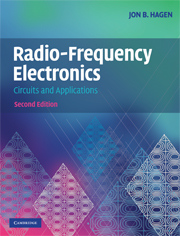Book contents
- Frontmatter
- Contents
- Preface
- 1 Introduction
- 2 Impedance matching
- 3 Linear power amplifiers
- 4 Basic filters
- 5 Frequency converters
- 6 Amplitude and frequency modulation
- 7 Radio receivers
- 8 Suppressed-carrier AM and quadrature AM (QAM)
- 9 Class-C, D, and E Power RF amplifiers
- 10 Transmission lines
- 11 Oscillators
- 12 Phase lock loops and synthesizers
- 13 Coupled-resonator bandpass filters
- 14 Transformers and baluns
- 15 Hybrid couplers
- 16 Waveguide circuits
- 17 Small-signal RF amplifiers
- 18 Demodulators and detectors
- 19 Television systems
- 20 Antennas and radio wave propagation
- 21 Radar
- 22 Digital modulation techniques
- 23 Modulation, noise, and information
- 24 Amplifier and oscillator noise analysis
- 25 The GPS Navigation system
- 26 Radio and radar astronomy
- 27 Radio spectrometry
- 28 S-parameter circuit analysis
- 29 Power supplies
- 30 RF test equipment
- Index
5 - Frequency converters
Published online by Cambridge University Press: 05 June 2012
- Frontmatter
- Contents
- Preface
- 1 Introduction
- 2 Impedance matching
- 3 Linear power amplifiers
- 4 Basic filters
- 5 Frequency converters
- 6 Amplitude and frequency modulation
- 7 Radio receivers
- 8 Suppressed-carrier AM and quadrature AM (QAM)
- 9 Class-C, D, and E Power RF amplifiers
- 10 Transmission lines
- 11 Oscillators
- 12 Phase lock loops and synthesizers
- 13 Coupled-resonator bandpass filters
- 14 Transformers and baluns
- 15 Hybrid couplers
- 16 Waveguide circuits
- 17 Small-signal RF amplifiers
- 18 Demodulators and detectors
- 19 Television systems
- 20 Antennas and radio wave propagation
- 21 Radar
- 22 Digital modulation techniques
- 23 Modulation, noise, and information
- 24 Amplifier and oscillator noise analysis
- 25 The GPS Navigation system
- 26 Radio and radar astronomy
- 27 Radio spectrometry
- 28 S-parameter circuit analysis
- 29 Power supplies
- 30 RF test equipment
- Index
Summary
A common operation in RF electronics is frequency translation, whereby all the signals in a given frequency band are shifted to a higher frequency band or to a lower frequency band. Every spectral component is shifted by the same amount. Cable television boxes, for example, shift the selected cable channel to a low VHF channel (normally channel 3 or 4). Nearly every receiver (radio, television, radar, cell phone, …) uses the superheterodyne principle, in which the desired channel is first shifted to an intermediate frequency or “IF” band. Most of the amplification and bandpass filtering is then done in the fixed IF band, with the advantage that nothing in this major portion of the receiver needs to be retuned when a different station or channel is selected. The same principle can be used in frequency-agile transmitters; it is often easier to shift an already modulated signal than to generate it from scratch at an arbitrary frequency. Frequency translation is also called conversion and is even more commonly called mixing.
Voltage multiplier as a mixer
A mixer takes the input signal or band of signals (segment of spectrum), which is to be shifted, and combines it with a reference signal whose frequency is equal to the desired shift in frequency. In a radio receiver, the reference or “L.O.” signal is a sine-wave, generated within the receiver by a local oscillator.
- Type
- Chapter
- Information
- Radio-Frequency ElectronicsCircuits and Applications, pp. 46 - 53Publisher: Cambridge University PressPrint publication year: 2009



